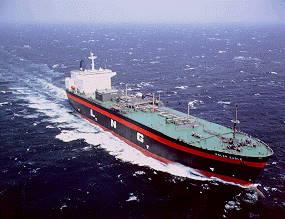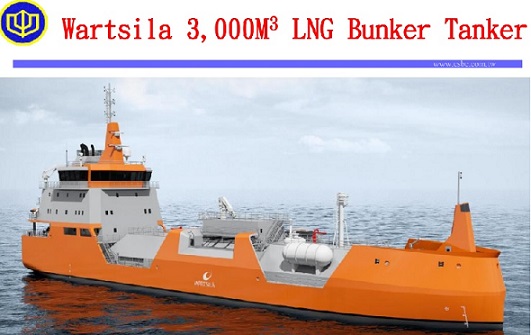
Fig:LNG carrier underway
Carbon emissions have long been a concern there, spurring many several to adopt LNG as fuel. Fuel tank placement is a special concern. LNG is not as dense as petroleum, requiring between double and triple the space for the fuel tank. To alleviate the loss of space, some Norwegian designers locate the tanks under accommodation spaces, building protective coffers to hold the tanks. Others have placed tanks on deck where they can vent into the atmosphere should a spill occur. IMO guidelines do not prohibit placement of LNG tanks under accommodation. However, the USCG feels the decision requires careful analysis.
Countries like Russia and Iran have vast gas fields, but the
process to bring it to the market is going slowly. Other producers like Qatar and Nigeria fast track their LNG projects to take advantage of this situation. Using gas fuel on LNGCs also has the added
advantage that it is more environmentally friendly in terms of emissions than HFO or even MDO. As it
is difficult to predict exactly where the markets are going, multi-fuel capability is definitely an
advantage for any LNGC.
Ship energy efficiency management plan
In MARPOL, a new chapter 4 on energy efficiency has been added to annex VI regulations on air pollution. It requires an Energy Efficiency Design Index (EEDI) to be stated for new vessels and a ship energy efficiency management plan to be maintained on all vessels. The EEDI is an indicator of the fuel efficiency of a ship, measured in grammes of CO2 emissions per deadweight tonne per nautical mile: the lower the figure, the better the fuel efficiency. The ship energy efficiency management plan aims to improve the efficiency of a vessel by introducing various management methods such as improved voyage planning to increase fuel efficiency.
Related article:
Increased Cargo Capacity for LNG ships & Advantages of the dual fuel diesel electric propulsion
Benifits of compressed gas technology
Procedure for transporting remote gas
Development and potential of todays emerging gas technologies
Transporting economically viable compressed gas liquids from remote fields
Defining various gas carrier types
Fuel flexibility of LNG ships
LNG ship spillage risk
LNG shipment
Initial Cool Down of cargo tanks
Leaks on the Cargo System, Continuous Flow - how to prevent
LNG tank leaks and immediate action by gas carriers
Leaks from a Loading Arm due to Tidal or Current Effects
Minor or major leaks from LNG tanks
Procedures for LNG cargo loading
Procedures for LNG cargo discharging
External links :
-
Types of liquefied gas carriers downloadable product

//
Home page///
LNG handling ///
LPG handling///
Sea transport ///
Gas products///
Cargo work
///
Fire precautions
///
Health hazards
///
Safety Precautions
///
Emergency response ///

Copyright © Liquefied Gas Carrier.com All rights reserved.
The content published in this website are for general reference only. We have endeavoured to make the information
as accurate as possible but cannot take responsibility for any errors. For latest information please visit www.imo.org .
Any suggestions, please Contact us !
///Links &Resources //
Terms of use///
Privacy policy///Home page///


